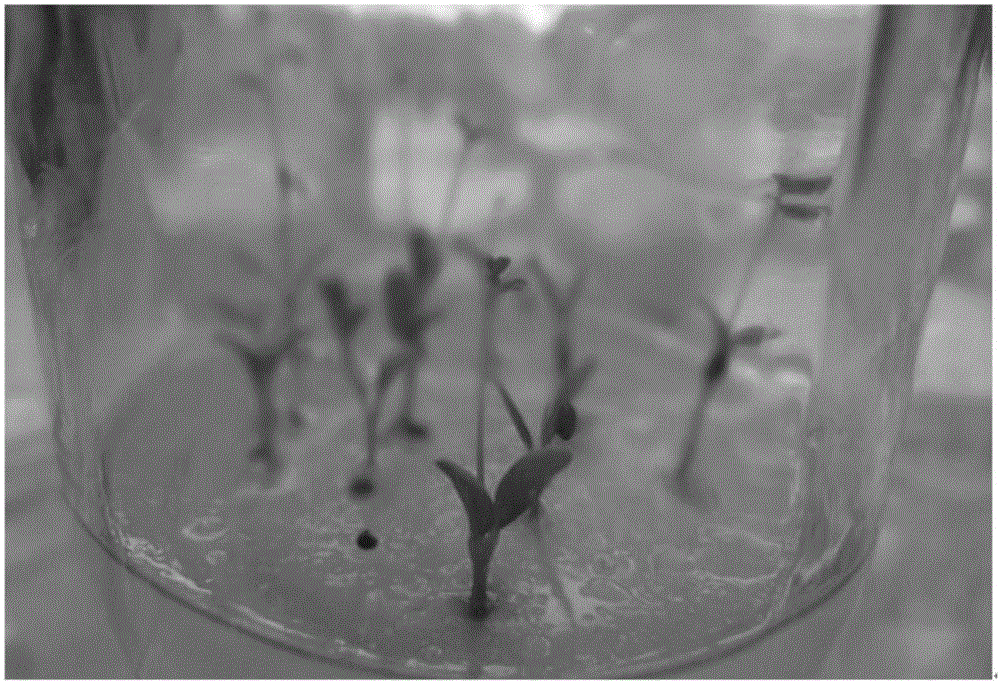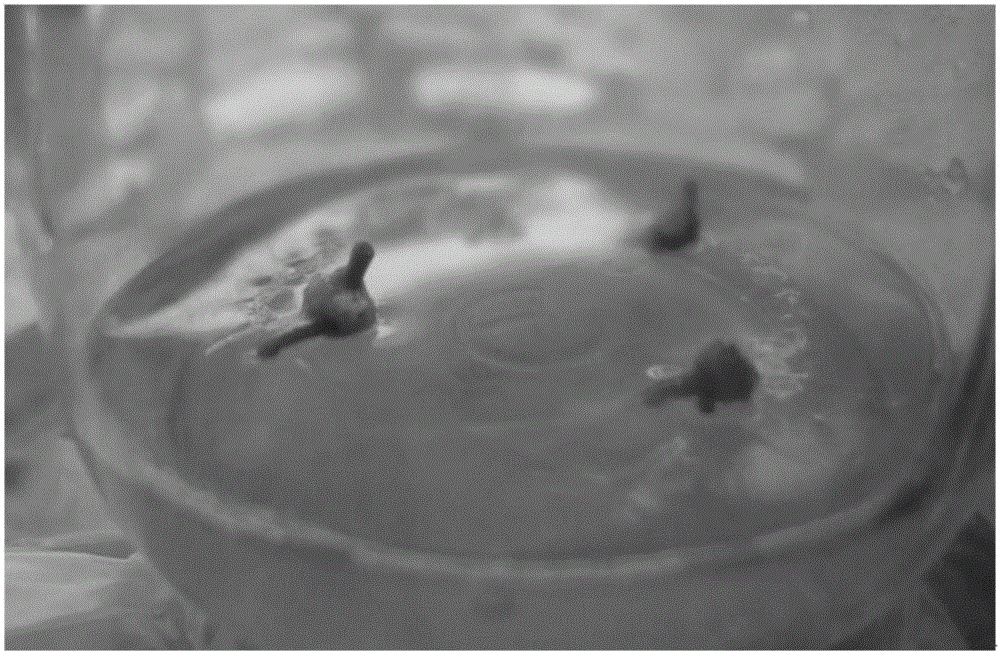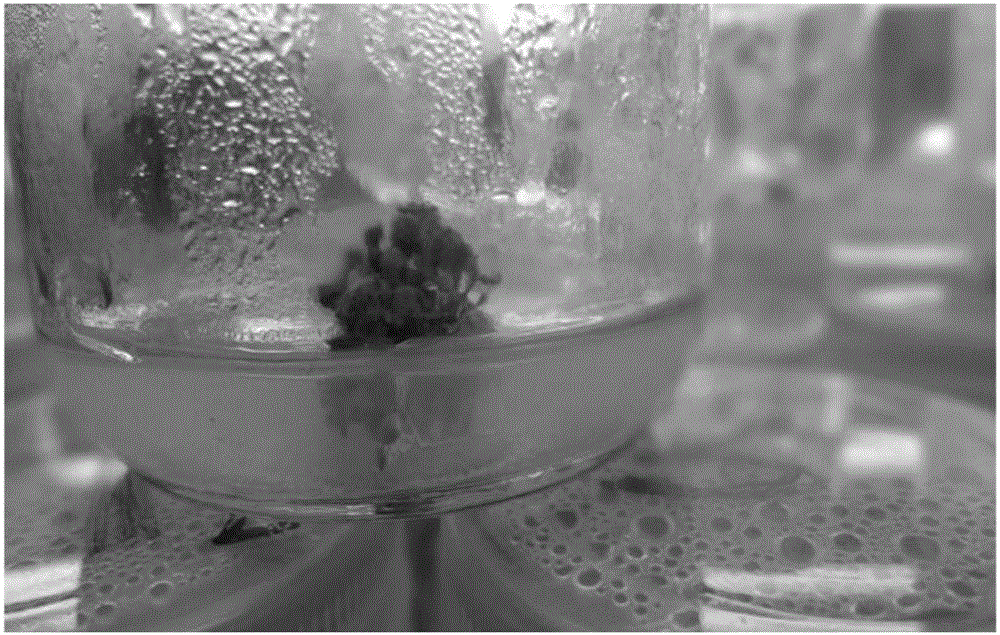Intermediate propagation method for Diqing wild Lores comiculatus Linn.
A technology of japonicus japonicus and wild type, which is applied in the field of plant propagation, can solve the problems of low reproductive coefficient of japonicus japonicus and slow growth of seedlings, and achieve the effects of shortening the breeding cycle, short propagation time and improving the reproductive coefficient
- Summary
- Abstract
- Description
- Claims
- Application Information
AI Technical Summary
Problems solved by technology
Method used
Image
Examples
Embodiment 1
[0017] 1) preparation of medium: select MS medium for use (include in every liter of medium: macronutrient 50ml, trace element 5ml, organic element 5ml, iron salt 5ml, sugar 30g, inositol 0.1g, agar powder 8g) pH is 5.8, the details are as follows: Take about 400ml of tap water and pour it into a small aluminum pot to heat. After the water boils, add 8g of agar powder and stir while heating. Be careful to prevent the bottom from sticking. It is better to melt completely and see the bottom. After 25 minutes, turn off the heat, add 30g of sucrose, 0.1g of inositol and the measured mother liquor medicine, and stir for 5 minutes. Pour into a 1000ml constant volume beaker to constant volume. Use a pH meter to measure the pH of the medium, and adjust it to about 5.8 pH with 0.1% NaOH or HCl solution when necessary. After adjusting the pH, be sure to stir evenly, and be careful not to use acid or alkali solutions that have been left for too long.
[0018] Described mother liquor me...
Embodiment 2
[0026] Step 1), step 2) are the same as embodiment 1,
[0027] 3) Induction of callus: when the seeds germinated on 14 days, two cotyledons were unfolded, and the hypocotyls were taken, cut into 0.5 cm long sections, and inoculated in a seed containing 2,4-D (2,4-dichlorobenzene). Oxyacetic acid) 2mg / L, KT (kinetin) 1mg / L, on the MS medium of pH=5.8, each treatment combination is repeated three times;
[0028] 4) Induced differentiation of buds: the hormone concentration combination medium for inducing bud differentiation is: MS medium containing 0.5 mg / L of NAA (naphthalene acetic acid) and 0.5 mg / L of 6-BA (6-benzylaminoadenine), followed by 18-32 days after the calli of passage 2-4 were inserted into the culture medium, the shoot length was observed;
[0029] 5) Root induction: When the induced buds grow to 5-8cm, cut the adventitious buds into 1.0cm small stem segments, each of which has at least one internode, and insert the lower end of the small stem segments containin...
Embodiment 3
[0031] Step 1), step 2) are the same as embodiment 1,
[0032] 3) Induction of callus: when the seeds germinated on 14 days, two cotyledons were unfolded, and the hypocotyls were taken, cut into 0.5 cm long sections, and inoculated in a seed containing 2,4-D (2,4-dichlorobenzene). Oxyacetic acid) 4mg / L, KT (kinetin) 5mg / L, on the MS medium of pH=5.8, each treatment combination is repeated three times;
[0033] 4) Induced differentiation of buds: The hormone concentration combination medium for inducing bud differentiation is: MS medium containing 1.5 mg / L of NAA (naphthalene acetic acid) and 0.5 mg / L of 6-BA (6-benzylaminoadenine), followed by 18-32 days after the calli of passage 2-4 were inserted into the culture medium, the shoot length was observed;
[0034] 5) Root induction: When the induced buds grow to 5-8cm, cut the adventitious buds into 1.0cm small stem segments, each of which has at least one internode, and insert the lower end of the small stem segments containin...
PUM
 Login to View More
Login to View More Abstract
Description
Claims
Application Information
 Login to View More
Login to View More - R&D
- Intellectual Property
- Life Sciences
- Materials
- Tech Scout
- Unparalleled Data Quality
- Higher Quality Content
- 60% Fewer Hallucinations
Browse by: Latest US Patents, China's latest patents, Technical Efficacy Thesaurus, Application Domain, Technology Topic, Popular Technical Reports.
© 2025 PatSnap. All rights reserved.Legal|Privacy policy|Modern Slavery Act Transparency Statement|Sitemap|About US| Contact US: help@patsnap.com



